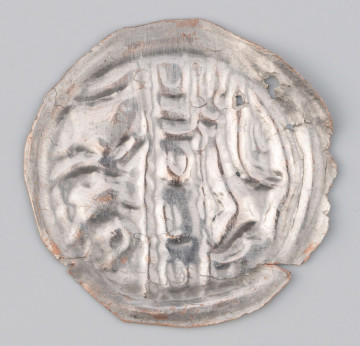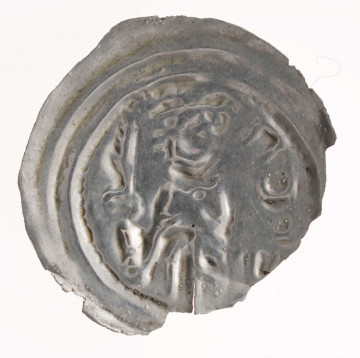
Bracteate of Mieszko III the Old
1181 — 1202
National Museum in Lublin
Part of the collection: Money on Polish territory in the Middle Ages
The deprivation of the throne by the senior member of the Piast dynasty, Władysław the Exile (1138-1146), made it possible for his half-brother Bolesław the Curly (1146-1173) to take power in the Polish district. Among the powers associated with the scope of his sovereignty, he had the exclusive right to issue money.
During the twenty-seven years of his reign, Bolesław the Curly-head issued several types of denars, with different images. Their introduction into circulation was accompanied by the exchange of the previous type, according to a conversion scheme favourable to the issuer (for example, three old denarii for two new ones). The resulting profit – usually at the level of several dozen percent – brought considerable income to the ducal treasury. The frequent exchange caused social discontent, which in certain circumstances could have turned into a revolt. To avoid this, Bolesław the Curly, succumbed to the influence of the mighty and did not follow his predecessor in limiting the frequency of the exchange every 4-5 years.
After the issue of a denarius depicting the duke on his throne, with a sword on his knees and the head of St Adalbert in a reliquary on the reverse (1146-1152), the type with the image of the duke in armour, holding a spear with a pennant and a shield, was introduced into circulation, and on the reverse was a representation of two figures behind a table, holding the apple of lordship. They should be identified with the Senior Prince and his brother Mieszko. The issue of this coin dates to the years 1152-1157. The depiction on the obverse was a manifestation of the knightly, warlike role of the Christian ruler, called by the will of God to defend the state and the Church against physical and spiritual evil. On the other hand, the representation on the reverse shows the consensual, peaceful reign of the senior prince in the country, based on cooperation with his adult brother Mieszko, after a period of fratricidal fighting of the past reign. It is symbolised by the jointly held reigning apple, which at that time was probably not a real insignia, but a symbol of power.
Denars of Prince Bolesław were in use for several decades, at the latest until the turn of the 12th and 13th centuries.
Tomasz Markiewicz
Author / creator
Dimensions
cały obiekt: diameter: 16,7 mm
Object type
numismatic
Technique
stamp minting
Material
silver
Creation time / dating
Creation / finding place
Owner
The National Museum in Lublin
Identification number
Location / status

1181 — 1202
National Museum in Lublin

1180 — 1199
National Museum in Lublin

1181 — 1202
National Museum in Lublin
DISCOVER this TOPIC
National Museum in Szczecin
DISCOVER this PATH
Educational path